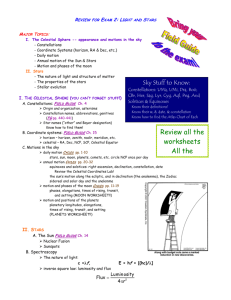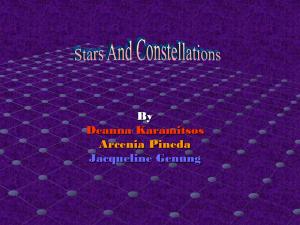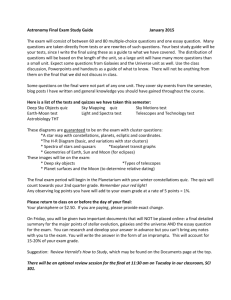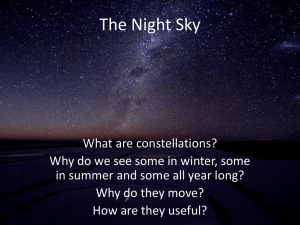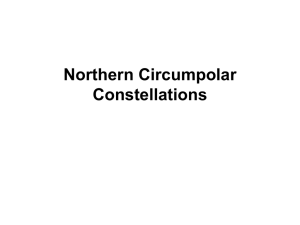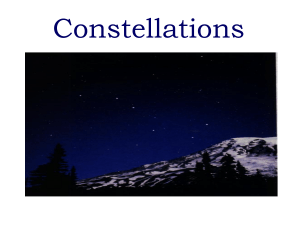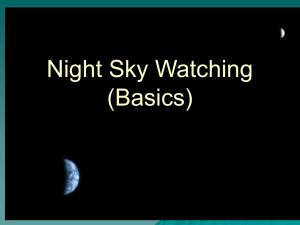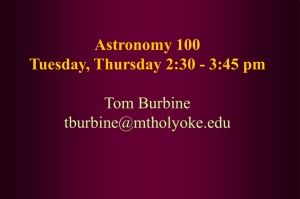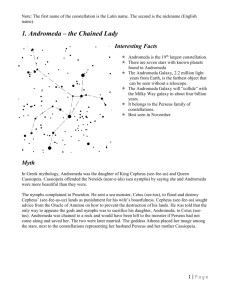Unit 1 Lecture Notes
advertisement
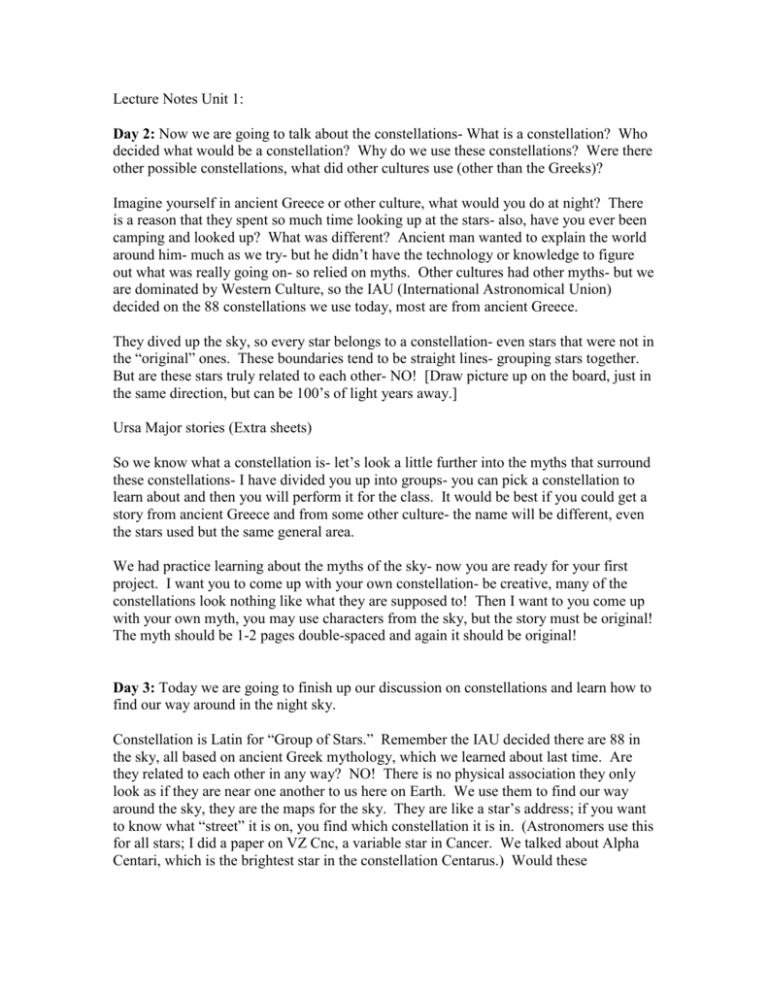
Lecture Notes Unit 1: Day 2: Now we are going to talk about the constellations- What is a constellation? Who decided what would be a constellation? Why do we use these constellations? Were there other possible constellations, what did other cultures use (other than the Greeks)? Imagine yourself in ancient Greece or other culture, what would you do at night? There is a reason that they spent so much time looking up at the stars- also, have you ever been camping and looked up? What was different? Ancient man wanted to explain the world around him- much as we try- but he didn’t have the technology or knowledge to figure out what was really going on- so relied on myths. Other cultures had other myths- but we are dominated by Western Culture, so the IAU (International Astronomical Union) decided on the 88 constellations we use today, most are from ancient Greece. They dived up the sky, so every star belongs to a constellation- even stars that were not in the “original” ones. These boundaries tend to be straight lines- grouping stars together. But are these stars truly related to each other- NO! [Draw picture up on the board, just in the same direction, but can be 100’s of light years away.] Ursa Major stories (Extra sheets) So we know what a constellation is- let’s look a little further into the myths that surround these constellations- I have divided you up into groups- you can pick a constellation to learn about and then you will perform it for the class. It would be best if you could get a story from ancient Greece and from some other culture- the name will be different, even the stars used but the same general area. We had practice learning about the myths of the sky- now you are ready for your first project. I want you to come up with your own constellation- be creative, many of the constellations look nothing like what they are supposed to! Then I want to you come up with your own myth, you may use characters from the sky, but the story must be original! The myth should be 1-2 pages double-spaced and again it should be original! Day 3: Today we are going to finish up our discussion on constellations and learn how to find our way around in the night sky. Constellation is Latin for “Group of Stars.” Remember the IAU decided there are 88 in the sky, all based on ancient Greek mythology, which we learned about last time. Are they related to each other in any way? NO! There is no physical association they only look as if they are near one another to us here on Earth. We use them to find our way around the sky, they are the maps for the sky. They are like a star’s address; if you want to know what “street” it is on, you find which constellation it is in. (Astronomers use this for all stars; I did a paper on VZ Cnc, a variable star in Cancer. We talked about Alpha Centari, which is the brightest star in the constellation Centarus.) Would these constellations look the same from other places? Pluto? Alpha Centari? A distant star? [Show Battlestar clip] One star we need to talk about in particular is the North Star, or Polaris (Alpha Ursae Minoris). What is special about this star? It always points north and it can tell you your latitude. Does anyone know the latitude here at American Fork? 40 degrees north, so Polaris is 40 degrees above the horizon. Anciently people believed that the Earth was in the center of a hollow sphere. All the stars were points of light on the outside of this sphere and that was the extent of the universe. This is not correct, but we still use the idea of a celestial sphere as another guide for us around the sky. Exactly like our globe, there is a North Celestial Pole, South Celestial Pole and Celestial equator. The sphere’s longitude and latitude are called Right Ascension (RA) and Declination (dec). One other important thing to note, no matter where you are, the point directly above you is called the zenith. We are now going to talk about a specific group of constellations: the Zodiac (meaning circle of animals). What is the Zodiac, what makes these constellations different from the others? The Zodiac constellations are those that lie along the ecliptic (the path the sun makes in the sky). These constellations were used by astrologers (and still are) to predict the future. This is a pseudoscience; it is not very accurate. Just to test this idea we are going to look at past President’s birthdays! [President birthday activity] There is actually a 13th zodiac constellation: Orphius. Most people have never heard of this constellation; it has been left out by astrologers for a multitude of reasons. One, 13 is an unlucky number so it was the one that was axed! Our Earth is spinning, and actually has another movement called precession. This means that the North Star will not always point north, in fact in 13,000 years Vega will point north! This means that when the astrology was invented, the Sun was in different constellations at different times than now. It turns out that the sun will move about 1 constellation every 2,000 years, which means that now (around 2,000 years after the invention of astrology) we are all off by one sign! Day 4: Brief History of Time There are two different “times” based on different things, the sun and the stars. Time based on the sun is Synodic time (solar time). Any guesses to how long? Exactly 24 hours long. Time based on the stars movement- sidereal time- is only 23 hrs. 56 min. (4 minutes difference). What does that mean about our night sky- this is the reason that the stars move each night, this is what changes the night sky. If you go out at 9 tonight and look up, it will be different than if you go outside in 6 months and look outside. This is because of the 4-minute differences between the two “times.” Now we are going to talk about how we measure a year. What is it based on? It is based on how long it takes the Earth to revolve around the Sun- approximately 365 days. Is that number perfect, does it take EXACTLY 365 days? No- that is why we have leap years, and actually a number of other fixes! The ancient Egyptians used a calendar that had exactly 365 days; this quickly became “off” the seasons (which are based on Earth’s revolution around the Sun). Ceaser had a calendar system that had 365.25 days, a leap year every four years. However every year was off by 11 minutes, which doesn’t seem like much, but over time it would build up! Based on this, spring now occurs in March but in 13,000 years spring would occur in September. Using this would eventually cause problems; it is just not accurate enough! In the 16th century the calendar was way off, 10 days! This meant that spring kept coming earlier and earlier in the year. The Roman Catholic Church did not like this; Easter is the Sunday after the full moon after the spring equnox. This meant that Easter was too early in the year, which they didn’t like. This was a time when the Church could do whatever it wanted; it was the real power. So in 1582 Pope Gregory XIII decreed that 10 days be dropped from the year, October 4 would be immediately followed by October 15. This was followed by riots and the like. Our calendar that we use now- the Gregorian calendar- is close to Ceaser’s but more accurate. There is a leap year every four ears, except at centuries that are not divisible by 400 (For example 1900 was not a leap year but 2000 was). That has one exception as well; a century that is divisible by 4000 is a not leap year. This seems really silly, but it makes the year very close to the actual number of 365.2422 (which is actually changing very slowly as well). Go into the math here- different calendar systems [extra worksheets] Now I will give you a planet and you need to come up with a calendar system that is both accurate and easy to use. [Years with different fractions 365.1234 or whatever!] How do astronomers avoid this nastiness? We use Julian Dates. This is basically star dates from Star Trek. This system is the number of days from a past starting number. Any guesses to that starting number? Remember this is not just days but hours and minutes, so fractions of days are a measurement of hours. Start time= January 1, 4713 BCE at 12 noon in Greenwich, England. Totally random! They wanted a date before any recorded history so that every celestial event could have a positive Julian Date. This is also based on Universal time, which is the time in Greenwich, England (excluding daylight savings). See how this could get a little complicated? Today’s Julian Date at ___________ a.m. is: 2455364.44653 (June 16, 2010 22:43 UT or 18:43 MST) Day 5: Today we are going to talk about the nature of light. Does light travel instantly? NO- it has a finite speed (approximately 3 x 108 m/s or 1.08 billion miles an hour or 9.46 trillion miles a year. It moves very fast (in fact faster than anything else in the universe) so it appears to our eyes to move instantaneously. We are going to venture into some modern physics here- what exactly is light? Is it a wave or a particle? Turns out it is both! Light travels as a wave, like waves on in a pond; it has a wavelength, which determines its energy. However, it also behaves like a particle, called a photon. Have you heard of a CCD? It is a device that counts photons from a source and makes a picture with it. We’ll talk more about it when we talk about telescopes tomorrow. Light makes up the Electromagnetic Spectrum (usually just abbreviated EM spectrum). You will need to know this! RADIO – MICROWAVES – INFRARED – VISIBLE – ULTRA VIOLET – X-RAYS – GAMMA RAYS Radio and microwaves are used in communications (as well as cooking food). They have longer wavelengths and lower energy. Infrared is heat; heat is actually a form of light! We can detect this but can’t see it (infrared goggles are often used in moves/TV shows to find people). Visible is that light that we can see and is only a small portion of the spectrum! Ultra violet is the type of light that gives you sunburns. X-rays are used in medical uses, they pass straight through human tissue but not bone. Gamma rays are also used for medical purposes, generally for treating cancer. Gamma rays are the most energetic and have the smallest wavelength. Anything above visible light is dangerous for humans and luckily for us the Earth’s atmosphere blocks most of that harmful radiation. Going back to visible light, what are the different “types?” Colors! Remember ROYGBIV; red light is the least energetic and the longest wavelength. [Pass out diffraction gratings and look at different light sources, not just white light] Newton figured out that light was made up of these different colors. Using a prism he split light into a rainbow, but to be sure the colors were not made in the glass he put a filter and only let one color through, found it was not in the glass! Day 6: Important notes to get from the activity: Galileo Era: 1609- 401 years ago! He was the first to see craters on the moon and that planets other than ours can have moons! He rocked the boat; the Catholic Church did not like the idea that the celestial spheres were not perfect (especially the moon). Early Refractors: Kepler worked on optics to improve telescopes. Encountered a problem called spherical aberration, which meant that these telescopes needed to be longer than practical. Great Refractors: New lenses fixed the spherical aberration problem but glass naturally has imperfections. The first telescopes used with photography, however a huge limit to how big they can be. Newton’s Era: These telescopes had little aberration and were smaller. They were made with tin mirrors. However there was a problem with blurry images. Also tin does not get very bright and will tarnish easily. Early Reflectors: Ended spherical aberration forever! However they were limited by the size of the mirror (hard to make good mirrors big). Hug Reflectors: New mirrors were used, bigger and better. Now location mattered, had to deal with light pollution. Could use these with photography and get longer exposure times, meaning you could see fainter objects (those not visible to our eyes). Radio: These allowed astronomers to observe all day! Many new objects could be studied, and could study the composition of these objects. Solar: See features on the sun. Magnifying is more important than light gathering (not true of all other telescopes) Multi-Mirrored: Much easier than one big mirror. Coupled with a CCD device can measure the intensity of the light. Space: All the problems with the atmosphere (weather and dimming effects) are no longer a problem. Can look at all wavelengths (those that are blocked by the atmosphere, like XRay and Gamma ray). Telescopes: Astronomers are observers; we don’t get to experiment hardly ever! All of what we know is from what we can see; however this has been improved with different wavelengths. A telescopes main job is to collect light, not to magnify! This makes them better than our eyes, can see further and fainter objects because can collect and concentrate the light (also collect light over time). There are two types of telescopes, reflecting (mirror) and refracting (lens). A lens bends the light and brings it to a focal point. However the biggest drawback is that the telescope must be very long to accommodate the focal length. Reflecting telescopes reflect the light and bring it to a focal point in a much small space. Two important things to be aware of: light pollution and seeing. If you live in a populated area, the sky never gets completely dark and it is difficult (if not impossible) to see fain objects. All along the Wasatch front there is extensive light pollution, but once you get off the front here in Utah the light pollution is very little (show light pollution map overhead). Seeing is turbulence in the air, mainly from water vapor. It is unavoidable and will make your image jump around the screen.


